The World Reimagined: Part Three
One of the best experiences I had when visiting Greenwich this year in the south east of the centre of London (down the Thames) was to see the The World Reimagined at the National Maritime Museum.
The World Reimagined created 103 unique globes across the UK exploring the history, legacy and future of the Transatlantic Trade in Enslaved Africans through the work of incredible artists.1
I was fortunate to see the 36 globes on exhibit outside the National Maritime Museum, Greenwich, the last ones of which I'll show you today.
The globes, each created by a different artist, are grouped into the themes of: Mother Africa, The Reality of Being Enslaved, Stolen Legacy: The Rebirth of a Nation, Abolition & Emancipation, A Complex Triangle, Echoes in the Present, Still We Rise, Expanding Soul, Reimagine the Future and Community.
Let us start today by looking at the globe created by Emma Blake Morsi titled Maize and Grace in the theme of Mother Africa.
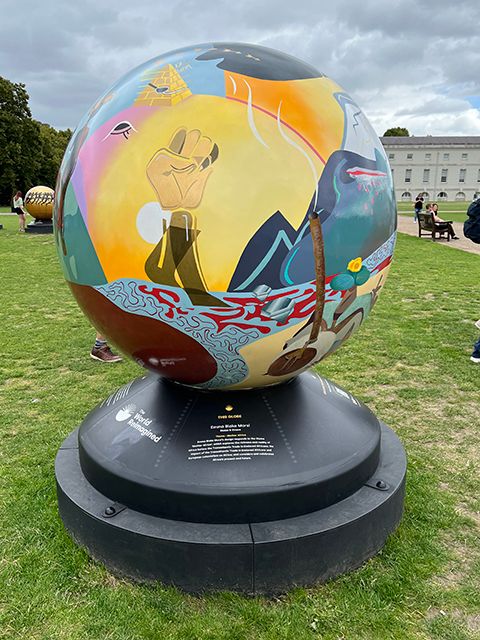
Artist's Statement
The Courageous Untold Stories of African Environmental Heroes & Sovereignty Guardians.1
My globe responds to the Mother Africa theme and utilises key symbolism and references that highlight and reimagine much of the inspirational parts of global history, where the untold stories of African environmental heroes and sovereignty guardians are centred. Inspired by the eclectic aesthetics, textures and history of the continent, I’ve incorporated my ‘Naturtraits’ style, which distinctly illustrates the connection between humans and nature through collaged silhouettes.1
Each section brings to life reimagined parts of our pre-colonial, traditional and colonial history as well as our present day reality and future potential. It aims to honour those who bravely fought for justice and our rights by reimagining them depicted in the dignity and peace in death that they didn’t always receive while alive, and to celebrate those who are paving the way for a brighter future. Despite representing a small percentage of the global population, indigenous people protect the vast majority of the world’s biodiversity.1
By focusing on the significant environmental legacy across the continent, it brings to light many of the courageous stories of those who have dedicated their lives to protecting the biodiversity of our richly diverse lands and as well as our rights to a healthier, greener life – preserving it for future generations. Likewise, this same approach honours the untold stories of our sovereignty guardians, who showed bravery in times of great vulnerability, as well as the significance of our global pre-colonial influence – a reminder of our potential and worth outside of Western context.1
Untold stories features the next generation of environmentalists, represented by Vanessa Nakate and brave ancestors like Ken Saro-Wiwa, president of the Movement for the Survival of Ogoni People who was executed in response to their activism against oil extraction in Ogoniland.1
It also features stories of great rulers, from the diasbled Queen Amanirenas of Kush and her legendary golden arrows and influence of Mansa Musa to traditional legacies, such as Àdìǹkrá symbols and Griots who keep traditions alive to this day.1
Voyage of the Guineamen is a globe created by Donna Newman in the theme of The Reality of Being Enslaved.
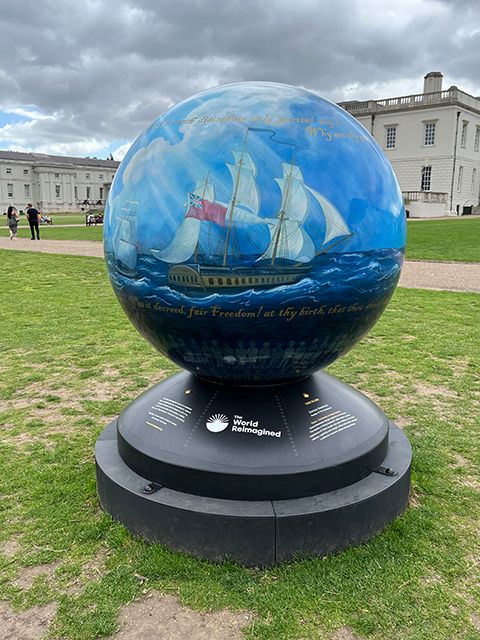
Artist's Statement
This design responds to the theme The Reality of Being Enslaved and in particular the story of Voyage. Whilst researching my design, I came upon the poem Slavery written by Hannah More, one of the most prominent female writers championing the abolitionist cause in eighteenth century Britain. I was particularly drawn to the lines of the poem which referred to light and darkness.1
I was reminded of the slave ships, or ‘Guineamen’ as they were known, and the horrific realities of the tortured human cargo crammed into their dark hulls. My design references the great maritime art of the eighteenth century and presents a subverted view of the golden age of sail. The glorious ships with their billowing white sails bathed in sunlight stand in stark contrast to what lies beneath.1
The base of the globe has been inspired by the 1791 Brookes slave ship diagram – one of the most recognisable images from the campaign to abolish the Transatlantic Trade in Enslaved Africans in Britain – which provided the public with a clear visual representation of conditions on board slave ships for the first time. From a distance the base appears as a pattern but on closer inspection the figures of the enslaved are revealed.1
Extracts of the poem wrap around my globe design, delivering a visual metaphor for the abundant wealth and pleasure that the sweat of the dead has procured for others.1
Also belonging to the theme of The Reality of Being Enslaved is Bought Sold and Gold created by Glen Brooks and Jane Mota.
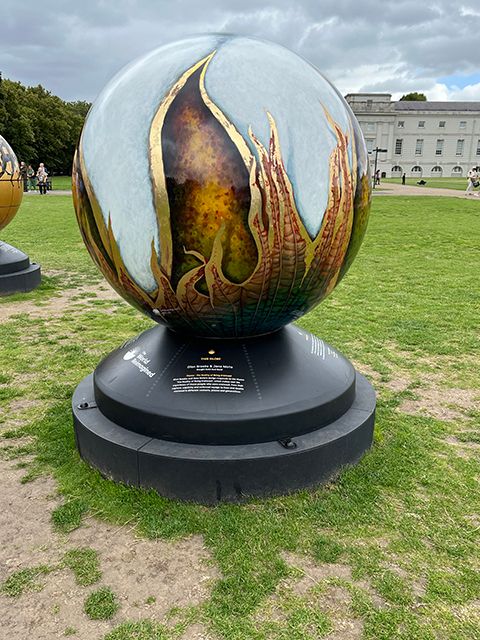
Artists' Statement
Our globe, which responds to The Reality of Being Enslaved theme, is a cotton ball which represents the enormous harvest expected daily by each enslaved person who worked on a cotton plantation. After the cotton gin was invented by Eli Whitney in 1793, the value of cotton soared and the industry grew rapidly. Although cotton itself is soft, it is surrounded by a hard and thorny structure that would cut the hands and legs of the workers, many of whom were children as young as eleven, who were considered to have the ideal height and hand size for picking. After a day of 12 to 18 hours each person’s harvest was weighed. There were severe consequences if the person did not meet the expectations.1
The red in our design represents the blood shed in this industry. From 1800-1860 enslaved African Americans harvested 2 billion pounds of cotton. Almost all of the 80% exported to Europe went to Britain where it was made into cloth and re-exported. Cotton was the most important raw material of the Industrial Revolution which was instrumental in creating our modern world economy.1
We want this globe to commemorate the humanity of those enslaved. We hope for public awareness and appreciation of the terrorism that was unleashed against millions of enslaved African men, women and children. We wish this to be a meditative memorial which considers and commemorates each life lost to the oppressive pursuit of the cotton cash crop.1
Leon Miller, BS51 has titled his globe with the same words as the theme it belongs to: Stolen Legacy: The Rebirth of a Nation.
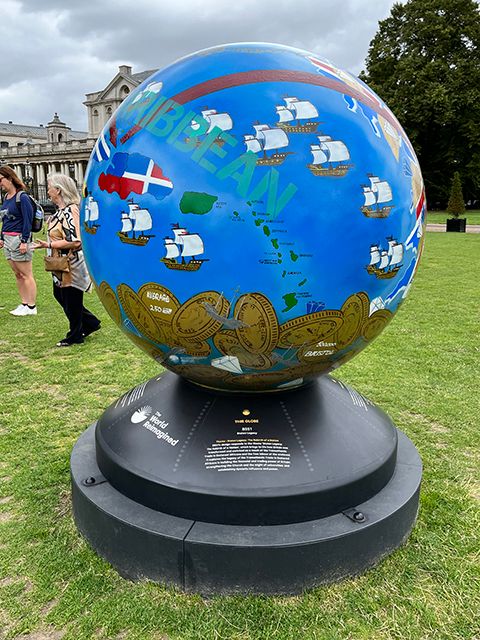
Artist's Statement
As our motorways are busy today, so once was the Atlantic Ocean’s triangle of trade routes between Britain, Africa and the Caribbean.1
The plunder of Africa’s gold, diamonds and people – taken to either the Caribbean or England – created great wealth for many men, such as Edward Colston in Bristol. As for the jewels in my design, large jewels have long been associated with the British monarchy. The arrows on the globe have texture to replicate dry blood from the skin of many millions of enslaved people who were beaten, tortured and killed during the TransatlanticTrade in Enslaved Africans. To have just sprayed red and gold paint on with a smooth finish felt wrong, when those journeys were far from smooth for the enslaved.1
There is a stitch – just one – which just says we are all the same underneath; can you find it?1
All arrows – all the money – point to England, whose wealth grew over the centuries of exploitation. Bristol became one of the biggest centres of the Transatlantic Trade in Enslaved Africans. How many buildings which adorn our city of Bristol were built by money from this trade? Even after the Abolition Act in 1834, enslavement carried on, with some British ships going under European flags and joining with foreign companies for many decades thereafter.1
There are three different types of ship on this globe; it’s for you to find them, see the difference, and make up your own mind as to what this means.1
Emotions have run high during the process of making this piece. I have come to tears sometimes trying to put myself in the situation that so many enslaved people were forced to endure. If this shows a fraction of what those people went through, don’t thank me, salute them for their bravery in the face of suffering: they were the true warriors.1
And finally and also from the theme of Stolen Legacy: The Rebirth of a Nation is At the Hands of the Enslaved, Our Society was Built by Alison Turner.
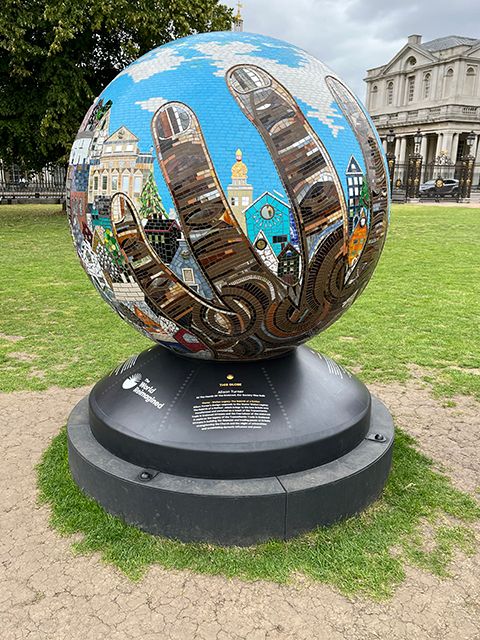
Artist's Statement
My design for the theme Stolen Legacy: Rebirth of a Nation will hopefully encourage the viewer to question their perspective on the history of the Transatlantic Trade in Enslaved Africans.1
I wanted to depict society being physically ‘held’ by the hands of an enslaved person, saying ‘Don’t forget us, our sacrifice is at the very soul of the society of which you are a part.’ I want to highlight the fact that our nation was created out of suffering and revisit the misplaced legacy towards the slave traders who benefitted from the barbaric treatment of the people they traded.1
Mosaic itself is diverse by its very nature. Using glass, pottery, ceramic tile, mirror and vintage crockery, I have included buildings in the cityscape which have specific and direct links to the slave trade including Speke Hall, Bristol Old Vic, Guinea Street and The Georgian House. The hands of the slave are edged in spent bullet casings to encourage the onlooker to consider the suffering and sacrifice made by the thousands of lives that were traded and disregarded…this globe is for them. To honour and remember exactly who built our society.1
Together we can look back and relearn history from another perspective in order to understand the generational effect slavery has had on our ancestors and in turn, improve our future. May we always remember the roots of the foundation of society for it has blood running through its veins. Hand Model – With thanks to Nathan Oladipo.1
The World Reimagined aims to transform how we understand the transatlantic slave trade and its impact on all of us, in order to make racial justice a reality.2
"We are living in a key moment for racial justice and it calls on us to courageously face our shared history with honesty, empathy and grace so we can create a new future in which all can say: I am seen."2
If you haven't checked out the official website for The World Reimagined please do so by following the link below. This way you can also read the bio information on each of the artists.
THE WORLD REIMAGINED
Click HereCredits
1. theworldreimagined.org
2. rmg.co.uk/whats-on/national-maritime-museum/world-reimagined
